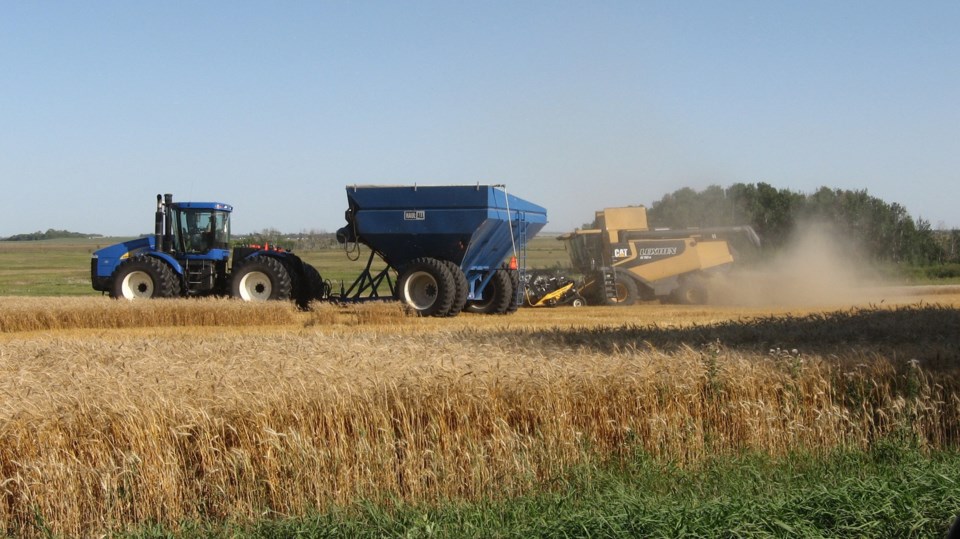Producers made significant harvest progress this week with 43 per cent of the crop now in the bin, up from 28 per cent last week and remaining well ahead of the five-year (2015-2019) average of 35 per cent for this time of year.
An additional 29 per cent of the crop is swathed or ready to straight-cut. While rain in some eastern and northern areas delayed harvest progress, the majority of the province continued harvest operations this week.
East-Central Saskatchewan:
·Crop District 5 – Melville, Yorkton, Cupar, Kamsack, Foam Lake, Preeceville and Kelvington areas
·Crop District 6A – Lumsden, Craik, Watrous and Clavet areas
Despite recent rain in much of the region, producers continue to make good harvest progress. Twenty-nine per cent of the crop is now in the bin, up from 20 per cent last week and ahead of the five-year (2015-2019) average of 25 per cent for this time of year. An additional 39 per cent of the crop is swathed or ready to straight-cut. Warm and dry weather would be appreciated so that producers can return to the field.
Rainfall ranged from nil to 29 mm in the Kelvington area, with most areas reporting over 10 mm. The Foam Lake and Saltcoats areas reported 13 mm, the Elfros and Kelliher areas 19 mm, the Pelly and Craik areas five mm, the Kuroki area 18 mm, the Bethune area one mm, the Earl Grey area 12 mm and the Yorkton area four mm. The Langenburg area has received the most precipitation in the region since April 1 with 306 mm.
Topsoil moisture conditions have improved slightly thanks to the recent rain. A large amount of moisture will be needed this fall to replenish both topsoil and subsoil moisture for next year. Cropland topsoil moisture is rated as 41 per cent adequate, 36 per cent short and 23 per cent very short. Hay and pasture land topsoil moisture is rated as 27 per cent adequate, 43 per cent short and 30 per cent very short.
Most crops in the region are coming off tough or damp and are being placed into aeration bins and dryers. Reported yields are average, with some crops yielding less than anticipated due to the hot and dry conditions. The region received frost earlier this week and producers are assessing any damage done to immature crops. Strong winds continue to blow swaths around and have shelled out some standing crops.
Farmers are busy combining, swathing, moving cattle and hauling bales.
Provincially
The southwest region continues to have the most progress in the province with 71 per cent of the crop now combined. The southeast region has 59 per cent combined, the west-central 38 per cent, the east-central 29 per cent, the northeast 17 per cent and the northwest seven per cent.
Ninety-one per cent of lentils, 87 per cent of field peas, 73 per cent of mustard, 58 per cent of barley, 62 per cent of durum, 39 per cent of chickpeas, 32 per cent of spring wheat and 23 per cent of canola has now been combined. An additional 49 per cent of canola is swathed or ready to straight-cut.
Estimated average crop yields at this time are 45 bushels per acre for hard red spring wheat, 38 bushels per acre for durum, 67 bushels per acre for barley, 35 bushels per acre for canola, 39 bushels per acre for field peas and 1,548 pounds per acre for lentils. There are indications that the heat a few weeks ago has caused more damage in some crops than first anticipated.
Rainfall last week ranged from small amounts to 29 mm in the Kelvington area. Provincial topsoil moisture conditions continue to deteriorate with recent strong winds. Cropland topsoil moisture is rated as two per cent surplus, 34 per cent adequate, 41 per cent short and 23 per cent very short. Hay and pasture land topsoil moisture is rated as one per cent surplus, 23 per cent adequate, 42 per cent short and 34 per cent very short.
The majority of crop damage this past was due to strong winds, lack of moisture and frost. Most of the province received a hard frost earlier this week that caused damage to later-seeded and immature crops. Producers are assessing the damage to determine the potential impact. As field conditions remain very dry in some areas, seeding of winter cereals will be minimal this fall. Strong winds continue to blow swaths and shell standing crops.
Farmers are busy combining, swathing, baling straw and hauling bales.
With harvest underway in Saskatchewan, we want to remind producers to exercise caution and remain safe.



